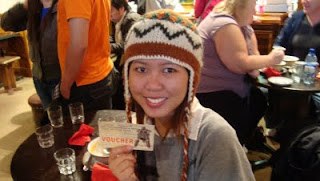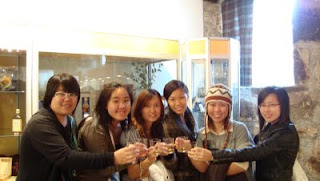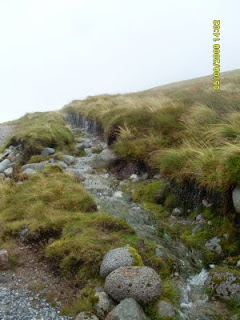4th September 2009
We departed from Liverpool in early morning 0:00. That was the time we had to say goodbye to our beloved hostel, Atlantic Point. We reached Newcastle at the middle of journey where a short stop was given. We had a great chance to see Angel of the north and The Sage Gateshead. It was very very windy and cold on that night. No one can bear it.
The Angel of the North is a contemporary sculpture designed by Antony Gormley, which is located in Gateshead, England. As the name suggests, it is a steel sculpture of an angel, standing 66 feel (20m) tall, with wings measuring 178 feet (54m) across- making it wider than the Statue of Liberty's height. The wings themselves are not planar, but are angled 3.5 degrees forward, which Gormley has said aims to create "a sense of embrace". It stands on a hill.
Pic: Angel of the North
The Gateshead Millennium Bridge is a pedestrian and cyclist tilt bridge spanning the River Tyne in England between Gateshead on the south bank, and the Quayside of Newcastle upon Tyne on the north bank. The award-winning structure was conceived and designed by architects Wilkinson Eyre and structural engineers Gifford. The bridge is often referred to as the "Winking Eye Bridge" due to its elliptical shape and its rotational movement.
Pic: Newcastle Millennium Bridge

We reach Edinburgh - the capital of Scotland at around 7.30 am in the morning. Still, it was cold with rain. We stopped at a railway station to clean ourselves up. I should not have just worn a short pant with a stocking beneath. That was not enough at all. I was shivering and forced to buy a cup of hot chocolate to keep myself warm. We were all trapped in the station by the rain. When the rain stopped, I was reluctant to leave the station as I knew I will get cold again. It was afternoon but I could hardly see the sun shine. We took a walk at this city which is famous for its arts, also a pre-eminence reflected in its hosting every year of Britain's largest arts extravaganza, the Endinburgh Festival. During the walk, we saw Edinburgh Castle.
Edinburgh Castle is a fortress which dominates the sky-line of the city of Edinburgh, Scotland, from its position atop the volcanic Castle Rock. The castle is now in the care of Historic Scotland, and is Scotland's second-most-visited tourist attraction. Although the garrison left in the 1920s, there is still a military presence at the castle, largely ceremonial and administrative, and including a number of regimental museums. It is also the backdrop to the annual Edinburgh Military Tattoo, and has become a recognisable symbol of Edinburgh and of Scotland.
Pic: Edinburgh Castle
There are a lot of shops selling cashmeres. They are really expensive. They cost around 35 pounds.
Pic: Cashmeres
The kilt is a knee-length garment with pleats at the rear, originating in the traditional dress of men and boys in the Scottish Highlands of the 16th century. Since the 19th century it has been associated with the wider culture of Scotland in general, or with Celtic (and more specifically Gaelic) heritage elsewhere. It is most often made of woollen cloth in a tartan pattern.Though the Scottish kilt is most often worn mainly on formal occasions or at Highland Gamesand sports events, it has also been adapted as an item of fashionable informal, and formal, male clothing in recent years.
Pic: Scottish Kilt

Later, we stopped by to have a try on Haggis. Haggis is a dish containing sheep's 'pluck' (heart, liver and lungs), minced with onion, oatmeal, suet, spices, and salt, mixed with stock, and traditionally boiled in the animal's stomach for approximately three hours. The haggis is a traditional Scottish dish memorialised as the national dish of Scotland by Robert Burns' poem Address to a Haggis in 1787. Haggis is traditionally served with "neeps and tatties" (Scots: swede, yellow turnip or rutabaga and potatoes, boiled and mashed separately) and a "dram" (i.e. a glass of Scotch whisky).
Pic: Haggis with neeps and tatties. Price: 10 pounds
Before going to the last stop, we entered Scottish Parliament.
Pic: Scottish Parliament
Last but not least, we went to Calton Hill. We had a chance to view Edinburgh from this up hill.
Pic: View from Calton Hill
We left Edinburgh and headed to Falkirk Wheel. It is a rotating boat lift connecting the Forth and Clyde Canal with the Union Canal. It is named after the nearby town of Falkirk in central Scotland. The two canals were previously connected by a series of 11 locks, but by the 1930s these had fallen into disuse, were filled in and the land built upon.
Pic: Falkirk Wheel
We spent our first night at a hotel in Glasgow. We did not miss any chance to experience the night view of Glasgow.
Pic: Glasgow Nite scenes
Pic: Bridge
Pic: Bridge

 We left the castle in 10 minutes because of the strong wind and rain. We headed to Ben Nevis Distillery, which is a whisky factory. At here, we were able to view the complete process of making whisky. A true Scottish whisky should contain at least 40 % alcohol. We were given a voucher worth 10 pounds and free testing of whisky. It was my first time consuming such a strong drink in my life. I was so happy to see my favorite highland cow just right beside the entrance.
We left the castle in 10 minutes because of the strong wind and rain. We headed to Ben Nevis Distillery, which is a whisky factory. At here, we were able to view the complete process of making whisky. A true Scottish whisky should contain at least 40 % alcohol. We were given a voucher worth 10 pounds and free testing of whisky. It was my first time consuming such a strong drink in my life. I was so happy to see my favorite highland cow just right beside the entrance.





















































